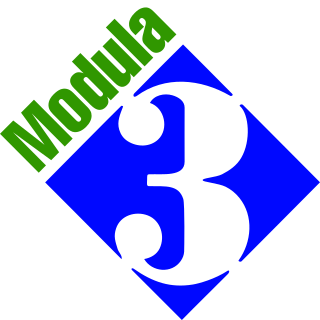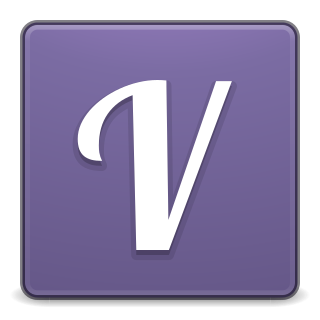OCaml is a general-purpose, high-level, multi-paradigm programming language which extends the Caml dialect of ML with object-oriented features. OCaml was created in 1996 by Xavier Leroy, Jérôme Vouillon, Damien Doligez, Didier Rémy, Ascánder Suárez, and others.

Curl is a reflective object-oriented programming language for interactive web applications which goal is to provide a smoother transition between content formatting and computer programming. It makes it possible to embed complex objects in simple documents without needing to switch between programming languages or development platforms. The Curl implementation initially consisted of an interpreter only; a compiler was added later.
Common Intermediate Language (CIL), formerly called Microsoft Intermediate Language (MSIL) or Intermediate Language (IL), is the intermediate language binary instruction set defined within the Common Language Infrastructure (CLI) specification. CIL instructions are executed by a CIL-compatible runtime environment such as the Common Language Runtime. Languages which target the CLI compile to CIL. CIL is object-oriented, stack-based bytecode. Runtimes typically just-in-time compile CIL instructions into native code.
Unit testing, a.k.a. component or module testing, is a form of software testing by which isolated source code is tested to validate expected behavior.

Modula-3 is a programming language conceived as a successor to an upgraded version of Modula-2 known as Modula-2+. While it has been influential in research circles it has not been adopted widely in industry. It was designed by Luca Cardelli, James Donahue, Lucille Glassman, Mick Jordan, Bill Kalsow and Greg Nelson at the Digital Equipment Corporation (DEC) Systems Research Center (SRC) and the Olivetti Research Center (ORC) in the late 1980s.
ABAP is a high-level programming language created by the German software company SAP SE. It is currently positioned, alongside Java, as the language for programming the SAP NetWeaver Application Server, which is part of the SAP NetWeaver platform for building business applications.
In computer science, reflective programming or reflection is the ability of a process to examine, introspect, and modify its own structure and behavior.

Apache Groovy is a Java-syntax-compatible object-oriented programming language for the Java platform. It is both a static and dynamic language with features similar to those of Python, Ruby, and Smalltalk. It can be used as both a programming language and a scripting language for the Java Platform, is compiled to Java virtual machine (JVM) bytecode, and interoperates seamlessly with other Java code and libraries. Groovy uses a curly-bracket syntax similar to Java's. Groovy supports closures, multiline strings, and expressions embedded in strings. Much of Groovy's power lies in its AST transformations, triggered through annotations.
In some programming languages, eval, short for the English evaluate, is a function which evaluates a string as though it were an expression in the language, and returns a result; in others, it executes multiple lines of code as though they had been included instead of the line including the eval. The input to eval is not necessarily a string; it may be structured representation of code, such as an abstract syntax tree, or of special type such as code. The analog for a statement is exec, which executes a string as if it were a statement; in some languages, such as Python, both are present, while in other languages only one of either eval or exec is.
Object Pascal is an extension to the programming language Pascal that provides object-oriented programming (OOP) features such as classes and methods.

The syntax of Java is the set of rules defining how a Java program is written and interpreted.
In computer programming, an entry point is the place in a program where the execution of a program begins, and where the program has access to command line arguments.
Harbour is a computer programming language, primarily used to create database/business programs. It is a modernised, open source and cross-platform version of the older Clipper system, which in turn developed from the dBase database market of the 1980s and 1990s.
In computer programming, a runtime system or runtime environment is a sub-system that exists both in the computer where a program is created, as well as in the computers where the program is intended to be run. The name comes from the compile time and runtime division from compiled languages, which similarly distinguishes the computer processes involved in the creation of a program (compilation) and its execution in the target machine.
SystemVerilog, standardized as IEEE 1800, is a hardware description and hardware verification language used to model, design, simulate, test and implement electronic systems. SystemVerilog is based on Verilog and some extensions, and since 2008, Verilog is now part of the same IEEE standard. It is commonly used in the semiconductor and electronic design industry as an evolution of Verilog.

Oxygene is a programming language developed by RemObjects Software for Microsoft's Common Language Infrastructure, the Java Platform and Cocoa. Oxygene is based on Delphi's Object Pascal, but also has influences from C#, Eiffel, Java, F# and other languages.

Vala is an object-oriented programming language with a self-hosting compiler that generates C code and uses the GObject system.

Spring Roo is an open-source software tool that uses convention-over-configuration principles to provide rapid application development of Java-based enterprise software. The resulting applications use common Java technologies such as Spring Framework, Java Persistence API, Thymeleaf, Apache Maven and AspectJ. Spring Roo is a member of the Spring portfolio of projects.
Objective-C is a high-level general-purpose, object-oriented programming language that adds Smalltalk-style messaging to the C programming language. Originally developed by Brad Cox and Tom Love in the early 1980s, it was selected by NeXT for its NeXTSTEP operating system. Due to Apple macOS’s direct lineage from NeXTSTEP, Objective-C was the standard programming language used, supported, and promoted by Apple for developing macOS and iOS applications until the introduction of the Swift programming language in 2014.

Nim is a general-purpose, multi-paradigm, statically typed, compiled high-level systems programming language, designed and developed by a team around Andreas Rumpf. Nim is designed to be "efficient, expressive, and elegant", supporting metaprogramming, functional, message passing, procedural, and object-oriented programming styles by providing several features such as compile time code generation, algebraic data types, a foreign function interface (FFI) with C, C++, Objective-C, and JavaScript, and supporting compiling to those same languages as intermediate representations.







